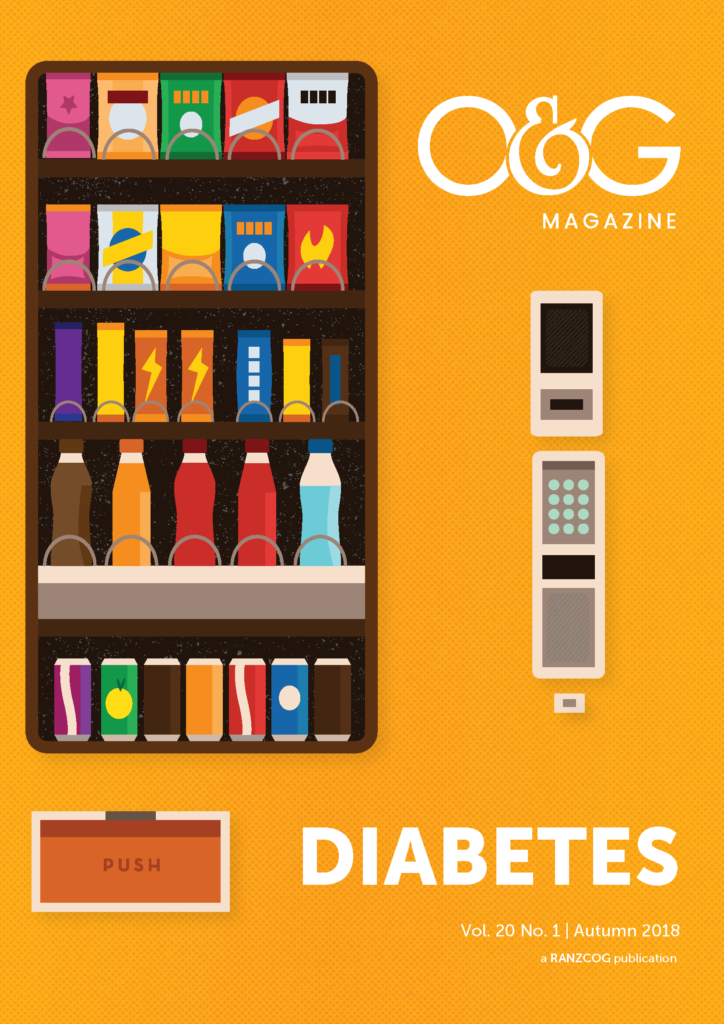The incidence of women with pre-existing diabetes mellitus (DM) falling pregnant, as well as the incidence of women with diabetes diagnosed during pregnancy, has increased over the last few years. Reasons for this include better glycaemic control improving fertility rates in pre-gestational DM, an increase in women with features of metabolic syndrome falling pregnant, and changes to the diagnostic criteria for gestational diabetes mellitus (GDM) – Australasian Diabetes in Pregnancy Society (ADIPS) criteria.1 The high-risk nature of these pregnancies has meant an increase in ultrasound scans and cardiotocography (CTG) monitoring, without much evidence to support these. This review focuses on the various methods used to assess the fetus across the trimesters in pregnancies in women with DM.
First trimester
The first trimester ultrasound is used to document viability and establish an accurate gestational age. The rate of miscarriage is increased in pregnancies complicated by DM, especially if the peri-conceptual glycaemia control has been poor. Establishment of a due date based on measurements of the developing embryo or fetus is the most accurate and evidence-based method of dating the pregnancy. It removes the inaccuracies that arise when the due date is calculated from the last menstrual period. This is more relevant for management in the third trimester, as most diabetic pregnancies have births scheduled.
Rates of autosomal chromosomal aneuploidy are not increased with DM, but the rates of anatomical abnormalities and possible sex chromosome aneuploidy are increased, once again especially in women with poor control. The first trimester screen has the advantage of being an early anatomy scan. It can detect anomalies such as large neural tube defects and surrogate markers for congenital heart disease, for example, an increased nuchal translucency. Rates of these are increased in diabetic pregnancies. The combined first trimester screen is the most common method used to screen for chromosomal aneuploidy in Australia and New Zealand. The levels of pregnancy-associated plasma protein A (PAPPA-A) and free beta-human chorionic gonadotrophin (β-hCG) are reduced in pregnancies affected by DM, and therefore must be adjusted
for this.2
Non-invasive prenatal testing for aneuploidy is not thought to be altered by DM in pregnancy, though this has not been specifically studied. In obese women, there is a higher chance of there being a ‘no-call’ result, due to reduced proportion of fetal cell-free DNA in the maternal circulation.
The Fetal Medicine Foundation3 has developed risk assessments for pre-eclampsia, fetal macrosomia and intrauterine growth restriction (IUGR) using maternal, biochemical and sonographic parameters. There are several publications outlining the evidence for these assessment tools and they all have DM status as one of the maternal medical characteristics, acknowledging the increased incidence of these conditions in affected pregnancies.
Second trimester
Assessment in the second trimester includes maternal serum screening and the anatomy scan around 20 weeks of gestation. Maternal serum screening is seldom performed in current obstetric practice, but can be if the woman is past the gestational age cut-off for the combined first trimester screen. Serum alfa-fetoprotein (AFP) and unconjugated oestriol are lower in diabetic pregnancies and adjustments need to be made for this.4 AFP is no longer used as a screening tool for open neural tube defects, but if significantly elevated, a detailed scan looking for this and other fetal anomalies should be performed.
The mid-trimester anatomy scan is the most detailed ultrasound in pregnancy and is a screening tool to detect fetal abnormalities. Fetuses of diabetic mothers have an increased risk of a range of abnormalities (four to eight times the background population); mainly neural tube defects, congenital heart disease (CHD), and the very rare sacral agenesis (caudal regression syndrome), the incidence of which is increased many-fold in poorly controlled diabetes mellitus. CHD is the leading organ-specific birth defect and is also the leading cause of infant mortality from congenital malformations.5 CHD accounts for about 50 per cent of diabetes-related major congenital anomalies.6 Attention should be paid to a detailed cardiac scan. Prenatal diagnosis of CHD remains a challenge, as the sensitivity of ultrasound has ranged from 15–39 per cent.7 The International Society of Ultrasound in Obstetrics and Gynaecology’s guidelines on examination of the fetal heart provide a systematic framework to detect CHD.8 Some centres refer all pregnant diabetic women for fetal echocardiography, whereas others reserve it for those with an abnormal initial cardiac screen.
Third trimester
The aims of fetal monitoring in the third trimester are to look for signs of the rare complication of impending fetal death in utero, to identify the macrosomic or IUGR fetus, and aim to schedule birth to minimise maternal and fetal complications. There are no large or randomised trials on which to make evidence-based recommendations as to which pregnancies should undergo fetal surveillance, when to start, what test to order, or how to perform it. Guidelines are therefore based on expert opinion and clinical experience. Monitoring is performed using serial ultrasound scans and CTG.
CTG technology was introduced in the 1980s and initial hopes that it would markedly reduce the perinatal mortality rates have not been proven. The latest Cochrane review in February 2016 on antenatal CTG for fetal assessment9 highlighted that ‘there is no clear evidence that antenatal CTG improves perinatal outcome, but further studies focusing on the use of computerised CTG in specific populations of women with increased risk of complications are warranted’. DM was one of the high-risk maternal conditions included in some studies in the review, but overall, the included studies were not of high quality. The consensus guidelines call for twice-weekly CTGs commencing from 32 weeks in complicated diabetic pregnancies, not limited to: fetal macrosomia or IUGR; pharmacological treatment; poor control; added risks such as hypertension or micro or macrovascular disease; and previous poor obstetric outcome. Intrapartum CTG monitoring is recommended in most circumstances, except for diet-controlled GDM with an unremarkable antenatal course.
Ultrasound has emerged as the other modality to assess and monitor the fetus in diabetic pregnancies. It is used to provide an estimate of the fetal weight and track fetal growth, and for fetal well-being when Doppler indices and amniotic fluid volume are assessed. Pregnancies in women with DM are commonly associated with accelerated growth, but are also at increased risk of IUGR. Guidelines exist from international societies on monitoring growth, ranging from a single third trimester scan, to serial growth scans beginning from 28 weeks gestation. A large for gestational age (LGA) fetus is variously defined as being over the 90th percentile for gestational age, or abdominal circumference over the 90th percentile, or both. The HAPO Study10 showed increases in primary caesarean delivery, neonatal hypoglycaemia and other maternal and neonatal morbidity when a LGA fetus or neonate was identified, but the study looked at outcomes in pregnancies with hyperglycaemia less severe than DM. This data is often extrapolated to include diabetic pregnancies
Increased fetal insulin production changes the anthropometric measurements of the fetus, specifically the chest-to-head and shoulder-to-head ratios, which accounts for the increase in the incidence of shoulder dystocia and associated birth injury, as compared to non-diabetic fetuses of a similar weight. There is no highly reliable method for identifying LGA fetuses antenatally as ultrasound tends to overestimate the fetal weight; the formula is very sensitive to measurement of the abdominal circumference. The increased prevalence of obesity in these women also reduces the ultrasound diagnostic quality, broadening the measurement error. Other parameters that have been studied include measuring the fetal liver, MRI, fractional limb volume, and subcutaneous fat measurements.11 These are not used in routine clinical practice. On the flip side, impaired growth is common among women with diabetic vaculopathy and/or superimposed pre-eclampsia. If there is evidence of IUGR, then tests of fetal well-being should be initiated. Special consideration should be given to women with poor control, in which the fetus appears average or slightly small. This is the situation of the ‘macrosomic growth restricted fetus’, where the two situations combine to give a deceptively normal fetus. This pregnancy should be carefully monitored.
Assessment of the diabetic pregnancy also includes ultrasound for fetal well-being; namely amniotic fluid volume and Doppler assessment. The amniotic fluid volume is prone to be increased in diabetic pregnancies, with several potential reasons for this. A larger baby is thought to produce increased volumes of urine. The osmotic pull of increased glucose in a hyperglycaemic fetus means it produces increased urine volumes.
DM is associated with an increased risk of sudden fetal death. Data from cordocentesis have demonstrated an association between maternal hyperglycaemia and fetal acidaemia in the absence of fetal hypoxaemia. It is this fetal acidaemia, thought to be the consequence of an increased metabolic rate, that may be the cause of the unexplained stillbirths in diabetic pregnancies. The aim of Doppler ultrasound is to identify the fetus at risk of adverse perinatal outcomes. Studies so far in diabetic pregnancies have been disappointing due to the inability to predict sudden fetal death. Doppler indices may be more useful in those pregnancies with vascular consequences, hypertensive disease and IUGR, where there are established guidelines on managing abnormal results. The parameters measured are the umbilical artery systolic/diastolic (S/D) ratio and pulsatility index (PI), the middle cerebral artery PI, the ductus venosus, and the uterine artery PI. The cerebroplacental ratio (CPR), which is the ratio of the fetal middle cerebral artery PI to the umbilical artery PI, has gained prominence as a marker for fetal compromise.12 A low CPR is associated with several adverse obstetric and perinatal outcomes, and can be considered a marker of suboptimal placental function. Gibbons et al recently showed that a low CPR in pregnancies complicated by GDM is associated with poorer neonatal outcomes, more so in the insulin-treated group.13 These findings could be extrapolated to include pre-gestational DM.
As can be seen, assessment and monitoring of pregnancies with DM is complex, with several guidelines constructed around consensus expert opinion. Local protocols should be established to manage these pregnancies according to the available resources.
References
- Nankervis A, et al. ADIPS Consensus Guidelines for the testing and diagnosis of hyperglycaemia in pregnancy in Australia and New Zealand. World Health Organisation. Diabetes fact sheet. Available: www. Sho.int/mediacentre/factsheets/fs312/en/
- Gurram P, Campbell W. Impact of diabetes on aneuploidy screening. Clin Lab Med 2013; 33: 271-280
- https://fetalmedicine.org. Fetal Medicine Foundation. Accessed October 2017
- Gurram P, Campbell W. Impact of diabetes on aneuploidy screening. Clin Lab Med 2013; 33: 271-280
- Centres for Disease Control and Prevention (CDC). Improved national prevalence estimates for 18 selected major birth defects: United States 1999-2001. Rep 2006; 54:1301-1305.
- Macintosh MC, et al. Perinatal mortality and congenital anomalies in babies of women with type 1 or type 2 diabetes in England, Wales and Northern Ireland: a population based study. BMJ 2006; 333:107.
- Acherman RJ, et al. Prenatal detection of congenital heart disease in Southern Nevada: the need for universal fetal cardiac evaluation. J Ultrasound Med 2007; 26:1715-1719
- Carvalho JS, et al. ISUOG practice guidelines (updated): sonographic screening examination of the fetal heart. Ultrasound Obstet Gynecol 2013; 41: 348-359
- Grivell RM, et al. Antenatal cardiotocography for fetal assessment. The Cochrane Library 2016; 123(4): 648.
- HAPO Study Cooperative Research Group. Hyperglycaemia and adverse pregnancy outcomes. N Eng J Med 2008; 358: 1991-2002
- Badreldeen A, et al. Role of ultrasound in the management of diabetes in pregnancy. Journal of Maternal-Fetal and Neonatal Medicine 2015; 28(15): 1856-1863
- Morales-Rosello J, Khalil A. Fetal cerebral redistribution: a marker of compromise regardless of fetal size. Ultrasound Obstet Gynecol 2015;46: 385-388
- Gibbons, et al. Cerebroplacental ratio in pregnancies complicated by gestational diabetes. Ultrasound Obstet Gynecol 2017; 50(2): 200-206.







Leave a Reply